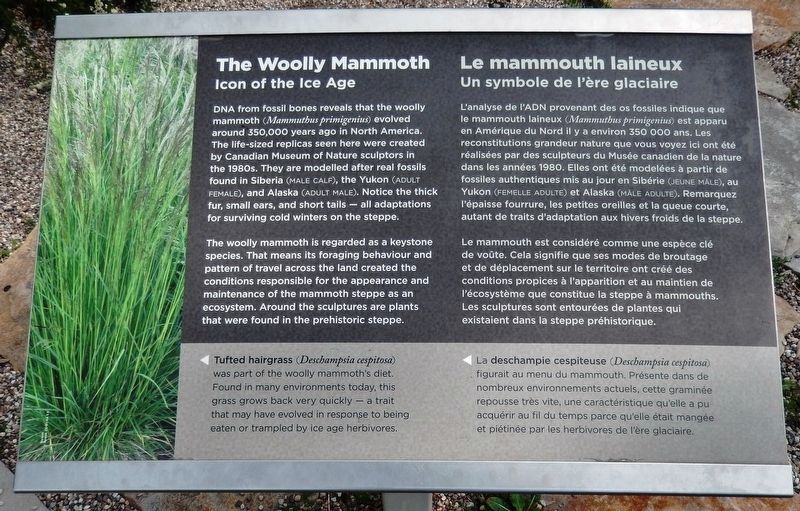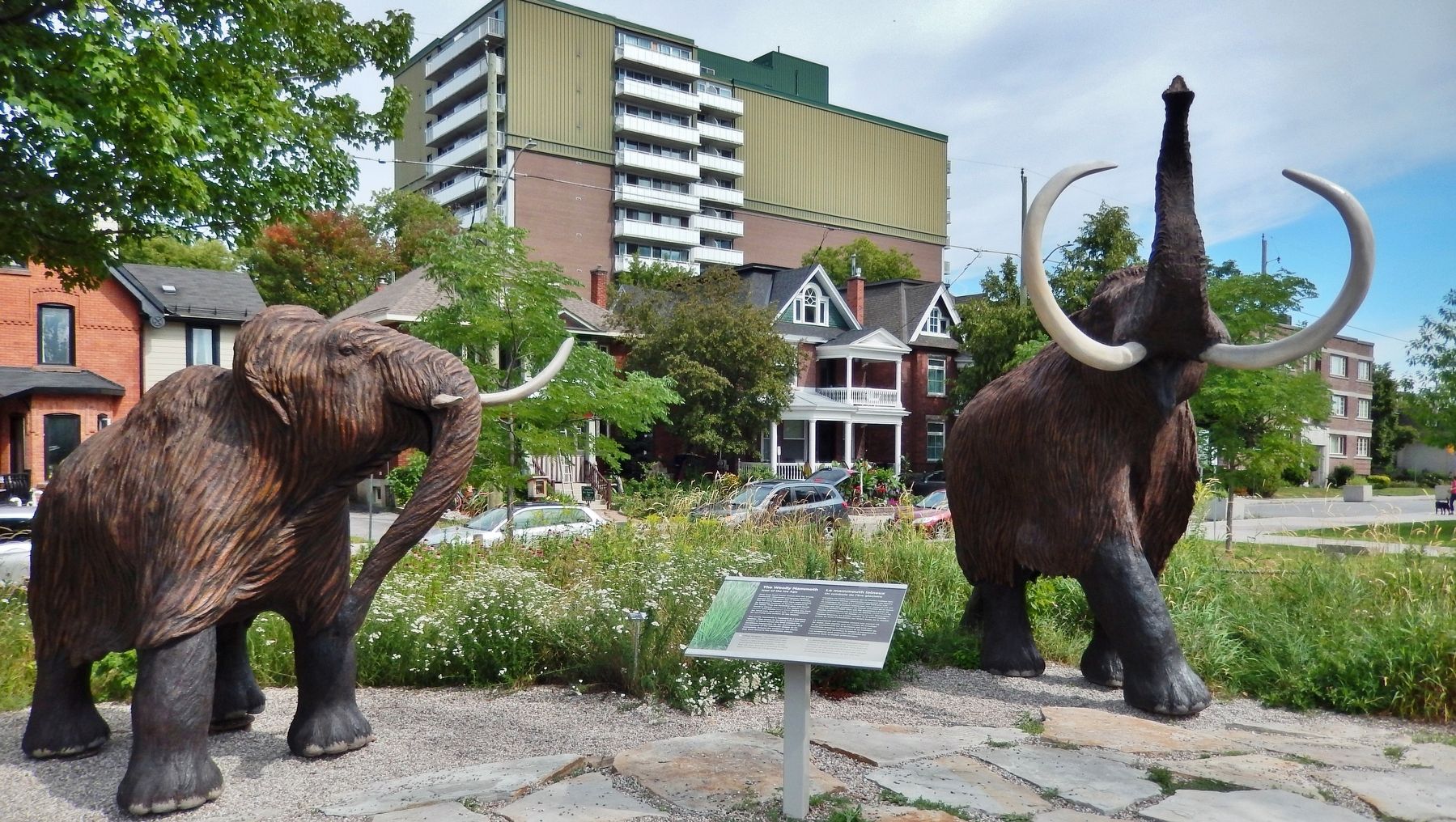Centretown in Ottawa, Ontario — Central Canada (North America)
The Woolly Mammoth / Le mammouth laineux
Icon of the Ice Age / Un symbole de l'ère glaciaire
DNA from fossil bones reveals that the woolly mammoth (Mammuthus primigenius) evolved around 350,000 years ago in North America. The life-sized replicas seen here were created by Canadian Museum of Nature sculptors in the 1980s. They are modelled after real fossils found in Siberia (MALE CALF), the Yukon (ADULT FEMALE), and Alaska (ADULT MALE). Notice the thick fur, small ears, and short tails — all adaptations for surviving cold winters on the steppe.
The woolly mammoth is regarded as a keystone species. That means its foraging behaviour and pattern of travel across the land created the conditions responsible for the appearance and maintenance of the mammoth steppe as an ecosystem. Around the sculptures are plants that were found in the prehistoric steppe.
Tufted hairgrass (Deschampsia cespitosa) was part of the woolly mammoth's diet. Found in many environments today, this grass grows back very quickly — a trait that may have evolved in response to being eaten or trampled by ice age herbivores.
L'analyse de l'ADN provenant des os fossiles indique que le mammouth laineux (Mammuthus primigenius) est apparu en Amérique du Nord il y a environ 350 000 ans. Les reconstitutions grandeur nature que vous voyez ici ont été réalisées par des sculpteurs du Musée canadien de la nature dans les années 1980. Elles ont été modelées à partir de fossiles authentiques mis au jour en Sibérie (JEUNE MÂLE), au Yukon (FEMELLE ADULTE) et Alaska (MÂLE ADULTE). Remarquez l'épaisse fourrure, les petites oreilles et la queue courte, autant de traits d'adaptation aux hivers de la steppe.
Le mammouth est considéré comme une espèce clé de voûte. Cela signifie que ses modes de broutage et de déplacement sur le territoire ont créé des conditions propices à l'apparition et au maintien de l'écosystème que constitue la steppe à mammouths. Les sculptures sont entourées de plantes qui existaient dans la steppe préhistorique.
La deschampie cespiteuse (Deschampsia cespitosa) figurait au menu du mammouth. Présente dans de nombreux environnements actuels, cette graminée repousse très vite, une caractéristique qu'elle a pu acquérir au fil du temps parce qu'elle était mangée et piétinée par les herbivores de l'ère glaciaire.
Topics. This historical marker is listed in these topic lists: Animals • Paleontology.
Location. 45° 24.758′
N, 75° 41.398′ W. Marker is in Ottawa, Ontario. It is in Centretown. Marker can be reached from McLeod Street just west of Metcalfe Street (Provincial Road 89), on the left when traveling west. Marker is located along the Landscapes of Canada Gardens walkway, on the west side of the Canadian Museum of Nature, just north of the museum parking lot. Touch for map. Marker is at or near this postal address: 240 McLeod Street, Ottawa ON K2P 2R1, Canada. Touch for directions.
Other nearby markers. At least 8 other markers are within walking distance of this marker. Victoria Memorial Museum Building (a few steps from this marker); John Macoun (about 90 meters away, measured in a direct line); Diamond Jenness (about 90 meters away); Parliament Fire (about 90 meters away); John R. Booth Residence / La Résidence de John R. Booth (approx. half a kilometer away); The Gouzenko Affair / L’Affaire Gouzenko (approx. 0.9 kilometers away); Igor Gouzenko (approx. 0.9 kilometers away); Marion Dewar Plaza (approx. 0.9 kilometers away). Touch for a list and map of all markers in Ottawa.
Also see . . . Woolly Mammoth (Mammuthus primigenius) (Wikipedia). Its closest extant relative is the Asian elephant. The appearance and behavior of this species are among the best studied of any prehistoric animal because of the discovery of frozen carcasses in Siberia and Alaska, as well as skeletons, teeth, stomach contents, dung, and depiction from life in prehistoric cave paintings. The woolly mammoth coexisted with early humans, who used its bones and tusks for making art, tools, and dwellings, and the species was also hunted for food. (Submitted on January 31, 2020, by Cosmos Mariner of Cape Canaveral, Florida.)
Credits. This page was last revised on January 24, 2022. It was originally submitted on January 26, 2020, by Cosmos Mariner of Cape Canaveral, Florida. This page has been viewed 168 times since then and 11 times this year. Photos: 1, 2. submitted on January 31, 2020, by Cosmos Mariner of Cape Canaveral, Florida.

